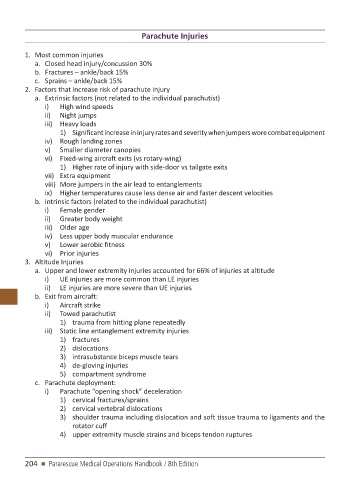Page 206 - PJ MED OPS Handbook 8th Ed
P. 206
Parachute Injuries
1. Most common injuries
a. Closed head injury/concussion 30%
b. Fractures – ankle/back 15%
c. Sprains – ankle/back 15%
2. Factors that increase risk of parachute injury
a. Extrinsic factors (not related to the individual parachutist)
i) High wind speeds
ii) Night jumps
iii) Heavy loads
1) Significant increase in injury rates and severity when jumpers wore combat equipment
iv) Rough landing zones
v) Smaller diameter canopies
vi) Fixed-wing aircraft exits (vs rotary-wing)
1) Higher rate of injury with side-door vs tailgate exits
vii) Extra equipment
viii) More jumpers in the air lead to entanglements
ix) Higher temperatures cause less dense air and faster descent velocities
b. Intrinsic factors (related to the individual parachutist)
i) Female gender
ii) Greater body weight
iii) Older age
iv) Less upper body muscular endurance
v) Lower aerobic fitness
vi) Prior injuries
3. Altitude Injuries
a. Upper and lower extremity injuries accounted for 66% of injuries at altitude
i) UE injuries are more common than LE injuries
ii) LE injuries are more severe than UE injuries
b. Exit from aircraft:
i) Aircraft strike
ii) Towed parachutist
1) trauma from hitting plane repeatedly
iii) Static line entanglement extremity injuries
1) fractures
2) dislocations
3) intrasubstance biceps muscle tears
4) de-gloving injuries
5) compartment syndrome
c. Parachute deployment:
i) Parachute “opening shock” deceleration
1) cervical fractures/sprains
2) cervical vertebral dislocations
3) shoulder trauma including dislocation and soft tissue trauma to ligaments and the
rotator cuff
4) upper extremity muscle strains and biceps tendon ruptures
204 n Pararescue Medical Operations Handbook / 8th Edition

